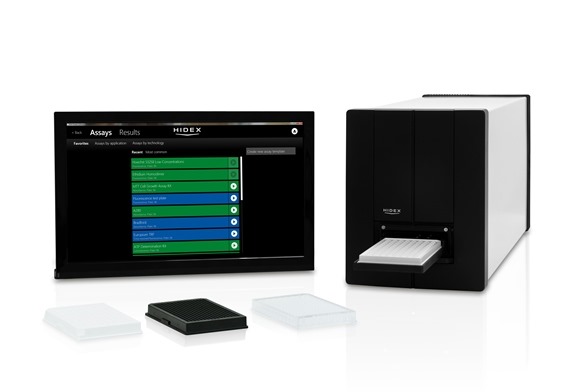Microplate readers: an interview with Ville Haaslahti, Managing Director, Hidex
Interview conducted by April Cashin-Garbutt, BA Hons (Cantab)

Please can you give an introduction to the Hidex Sense microplate reader?
The Hidex Sense is a new microplate reader which combines several different detection technologies. Such instruments have been available for quite some time already. What the Hidex Sense brings is really clearly defined in a few words: Every assay, effortless operation, performance beyond comparison, simply at your fingertip.
What we mean by this is that we have a microplate reader which is designed with absolutely no compromises on performance, but really with the user in mind. We are trying to speak the language of Biology and not engineers, and I think we’ve really pulled it off.

What applications can the Hidex Sense be used for?
The Hidex Sense can be used for virtually any assays. The software has a built-in library of common assays from commercial kit manufacturers as well as industry standard practices.
The navigation of the software is extremely easy either by most common or recent assays, by field of application like protein studies, nucleic acids, cell biology, reporter genes etc. or by detection technologies like absorbance, fluorescence, luminescence, FRET, TRF, TR-FRET. All of this on an intuitive touchscreen display. So it is really easy for a new comer to find what they need and start using the plate reader.
Is the Hidex Sense suitable for high speed kinetic studies?
Yes it certainly is. The Hidex Sense has a very high reading speed so you can cover the whole microplate in less than 15 seconds and make repeat measurements.
With the optional reagent injector module reactions can be started and stopped at precise time points and extremely fast reactions can be studied within the same microplate well. Injections can be made even simultaneously with the measurement using the bottom reading optics.
Are there any applications the Hidex Sense is not suited to?
Well it is hard to think of any. Now there is a special version of the Sense available which includes even detection of radiolabels such as tritium and carbon-14. Certain assays are still best done with radiolabels and as such they are extremely vital tools for applications in drug metabolism and pharmacokinetics.
Combined with the spectrometric measurement and the automatic injectors even radiolabelled binding studies can be monitored kinetically. This has never been possible before.
How does the Hidex Sense differ from other microplate readers?
We like to think that the Hidex Sense is really the first instrument which is designed for the user. Even though many of these technical features have been available before, the Hidex Sense is the first time we have combined them in a user friendly and intuitive way.
Also the exceptionally small footprint of the instrument is a real benefit. We all know how labs are crowded with instruments stacked on top of each other and shelves crammed with reagents and consumables. The compact design without compromise in performance is something we at Hidex had as a top design priority.

How much time needs to be spent on instrument training for this microplate reader?
That is really the whole point. When we spoke to users of our older microplate readers as well as the ones who did not like our old machines we realised one thing. People use these instruments periodically. You may using the machine intensively for 2 to 4 weeks and then have six months away from the machine.
In addition most plate readers are used by multiple research groups from different labs so it becomes more important to make the system productive.
These were the key points in our design. The instrument must be inviting and easy to use. You can see this in demonstrations and road shows all over the world. People start hesitantly with their arms crossed, but after five minutes they are pushing their colleagues aside and saying let me do that! It is that easy!
What are Hidex’s plans for the future?
Instruments are our thing. We have some really exciting new fluorescent technologies coming up, which we are not yet ready to talk about, but readers should stay in touch with our website and Facebook accounts to learn more.
Where can readers find more information?
Our website and facebook page are the best for news and information. We are also sure to let the readers of News Medical to know about new things that come up.
About Ville Haaslahti
 Ville graduated with a masters in electronic engineering and medical devices from the Aalto University. After graduation Ville worked as senior researcher at the University of Turku.
Ville graduated with a masters in electronic engineering and medical devices from the Aalto University. After graduation Ville worked as senior researcher at the University of Turku.
Ville has worked in several research R&D projects covering diagnostic instrumentation and PET chemistry development as well as several microplate reader and radiation detection instruments.
During his career he also held various marketing positions at Hidex. He has been the managing director of Hidex since 2009.
Ville is a co-author in several scientific publications and a co-inventor in several international patents.
0 comments:
Post a Comment